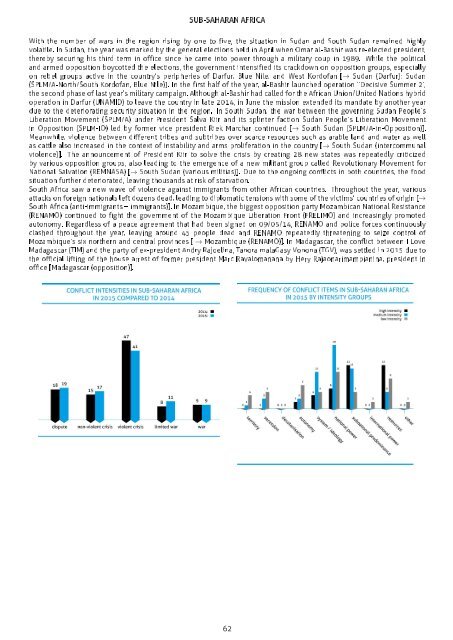ConflictBarometer_2015
ConflictBarometer_2015
ConflictBarometer_2015
Create successful ePaper yourself
Turn your PDF publications into a flip-book with our unique Google optimized e-Paper software.
SUB-SAHARAN AFRICA<br />
With the number of wars in the region rising by one to five, the situation in Sudan and South Sudan remained highly<br />
volatile. In Sudan, the year was marked by the general elections held in April when Omar al-Bashir was re-elected president,<br />
thereby securing his third term in office since he came into power through a military coup in 1989. While the political<br />
and armed opposition boycotted the elections, the government intensified its crackdown on opposition groups, especially<br />
on rebel groups active in the country's peripheries of Darfur, Blue Nile, and West Kordofan [→ Sudan (Darfur); Sudan<br />
(SPLM/A-North/South Kordofan, Blue Nile)]. In the first half of the year, al-Bashir launched operation ''Decisive Summer 2',<br />
the second phase of last year's military campaign. Although al-Bashir had called for the African Union/United Nations hybrid<br />
operation in Darfur (UNAMID) to leave the country in late 2014, in June the mission extended its mandate by another year<br />
due to the deteriorating security situation in the region. In South Sudan, the war between the governing Sudan People's<br />
Liberation Movement (SPLM/A) under President Salva Kiir and its splinter faction Sudan People's Liberation Movement<br />
in Opposition (SPLM-IO) led by former vice president Riek Marchar continued [→ South Sudan (SPLM/A-in-Opposition)].<br />
Meanwhile, violence between different tribes and subtribes over scarce resources such as arable land and water as well<br />
as cattle also increased in the context of instability and arms proliferation in the country [→ South Sudan (intercommunal<br />
violence)]. The announcement of President Kiir to solve the crisis by creating 28 new states was repeatedly criticized<br />
by various opposition groups, also leading to the emergence of a new militant group called Revolutionary Movement for<br />
National Salvation (REMNASA) [→ South Sudan (various militias)]. Due to the ongoing conflicts in both countries, the food<br />
situation further deteriorated, leaving thousands at risk of starvation.<br />
South Africa saw a new wave of violence against immigrants from other African countries. Throughout the year, various<br />
attacks on foreign nationals left dozens dead, leading to diplomatic tensions with some of the victims' countries of origin [→<br />
South Africa (anti-immigrants immigrants)]. In Mozambique, the biggest opposition party Mozambican National Resistance<br />
(RENAMO) continued to fight the government of the Mozambique Liberation Front (FRELIMO) and increasingly promoted<br />
autonomy. Regardless of a peace agreement that had been signed on 09/05/14, RENAMO and police forces continuously<br />
clashed throughout the year, leaving around 45 people dead and RENAMO repeatedly threatening to seize control of<br />
Mozambique's six northern and central provinces [ → Mozambique (RENAMO)]. In Madagascar, the conflict between I Love<br />
Madagascar (TIM) and the party of ex-president Andry Rajoelina, Tanora malaGasy Vonona (TGV), was settled in <strong>2015</strong> due to<br />
the official lifting of the house arrest of former president Marc Ravalomanana by Hery Rajaonarimampianina, president in<br />
office [Madagascar (opposition)].<br />
62


